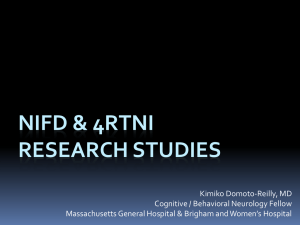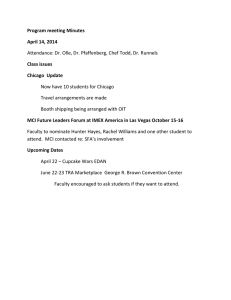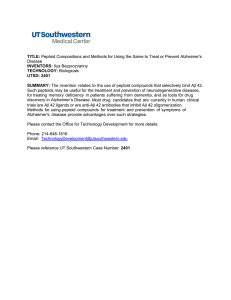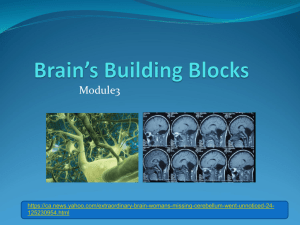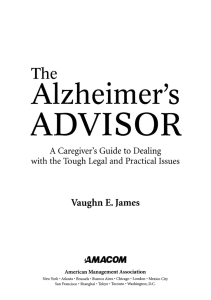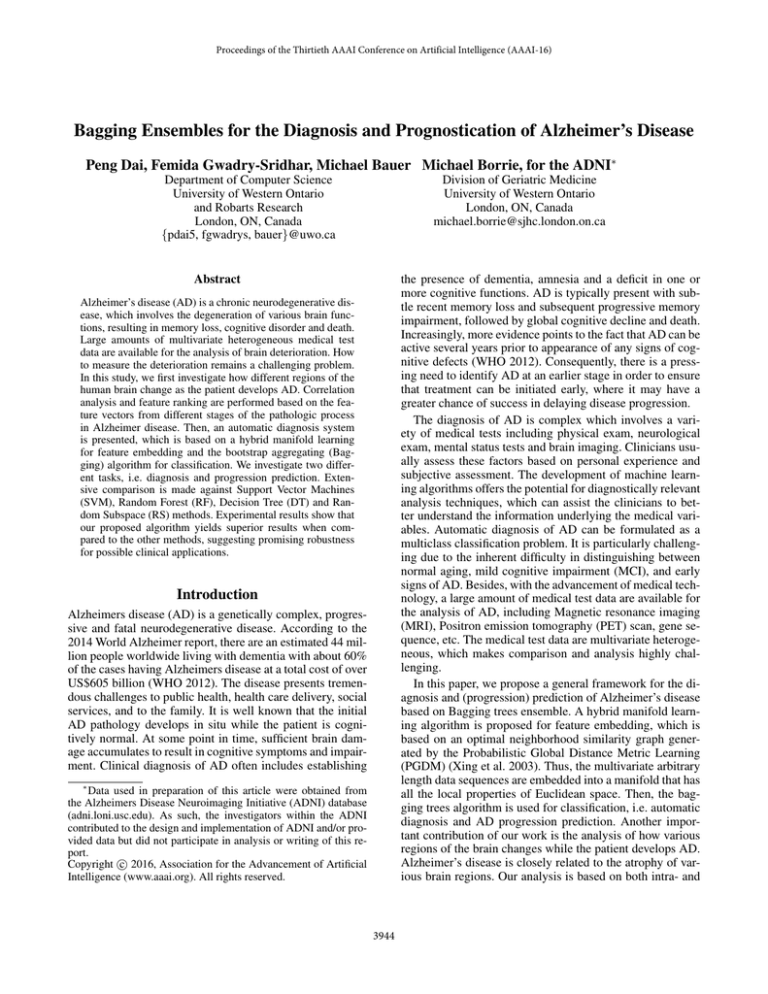
Proceedings of the Thirtieth AAAI Conference on Artificial Intelligence (AAAI-16)
Bagging Ensembles for the Diagnosis and Prognostication of Alzheimer’s Disease
Peng Dai, Femida Gwadry-Sridhar, Michael Bauer Michael Borrie, for the ADNI∗
Department of Computer Science
University of Western Ontario
and Robarts Research
London, ON, Canada
{pdai5, fgwadrys, bauer}@uwo.ca
Division of Geriatric Medicine
University of Western Ontario
London, ON, Canada
michael.borrie@sjhc.london.on.ca
the presence of dementia, amnesia and a deficit in one or
more cognitive functions. AD is typically present with subtle recent memory loss and subsequent progressive memory
impairment, followed by global cognitive decline and death.
Increasingly, more evidence points to the fact that AD can be
active several years prior to appearance of any signs of cognitive defects (WHO 2012). Consequently, there is a pressing need to identify AD at an earlier stage in order to ensure
that treatment can be initiated early, where it may have a
greater chance of success in delaying disease progression.
The diagnosis of AD is complex which involves a variety of medical tests including physical exam, neurological
exam, mental status tests and brain imaging. Clinicians usually assess these factors based on personal experience and
subjective assessment. The development of machine learning algorithms offers the potential for diagnostically relevant
analysis techniques, which can assist the clinicians to better understand the information underlying the medical variables. Automatic diagnosis of AD can be formulated as a
multiclass classification problem. It is particularly challenging due to the inherent difficulty in distinguishing between
normal aging, mild cognitive impairment (MCI), and early
signs of AD. Besides, with the advancement of medical technology, a large amount of medical test data are available for
the analysis of AD, including Magnetic resonance imaging
(MRI), Positron emission tomography (PET) scan, gene sequence, etc. The medical test data are multivariate heterogeneous, which makes comparison and analysis highly challenging.
In this paper, we propose a general framework for the diagnosis and (progression) prediction of Alzheimer’s disease
based on Bagging trees ensemble. A hybrid manifold learning algorithm is proposed for feature embedding, which is
based on an optimal neighborhood similarity graph generated by the Probabilistic Global Distance Metric Learning
(PGDM) (Xing et al. 2003). Thus, the multivariate arbitrary
length data sequences are embedded into a manifold that has
all the local properties of Euclidean space. Then, the bagging trees algorithm is used for classification, i.e. automatic
diagnosis and AD progression prediction. Another important contribution of our work is the analysis of how various
regions of the brain changes while the patient develops AD.
Alzheimer’s disease is closely related to the atrophy of various brain regions. Our analysis is based on both intra- and
Abstract
Alzheimer’s disease (AD) is a chronic neurodegenerative disease, which involves the degeneration of various brain functions, resulting in memory loss, cognitive disorder and death.
Large amounts of multivariate heterogeneous medical test
data are available for the analysis of brain deterioration. How
to measure the deterioration remains a challenging problem.
In this study, we first investigate how different regions of the
human brain change as the patient develops AD. Correlation
analysis and feature ranking are performed based on the feature vectors from different stages of the pathologic process
in Alzheimer disease. Then, an automatic diagnosis system
is presented, which is based on a hybrid manifold learning
for feature embedding and the bootstrap aggregating (Bagging) algorithm for classification. We investigate two different tasks, i.e. diagnosis and progression prediction. Extensive comparison is made against Support Vector Machines
(SVM), Random Forest (RF), Decision Tree (DT) and Random Subspace (RS) methods. Experimental results show that
our proposed algorithm yields superior results when compared to the other methods, suggesting promising robustness
for possible clinical applications.
Introduction
Alzheimers disease (AD) is a genetically complex, progressive and fatal neurodegenerative disease. According to the
2014 World Alzheimer report, there are an estimated 44 million people worldwide living with dementia with about 60%
of the cases having Alzheimers disease at a total cost of over
US$605 billion (WHO 2012). The disease presents tremendous challenges to public health, health care delivery, social
services, and to the family. It is well known that the initial
AD pathology develops in situ while the patient is cognitively normal. At some point in time, sufficient brain damage accumulates to result in cognitive symptoms and impairment. Clinical diagnosis of AD often includes establishing
∗
Data used in preparation of this article were obtained from
the Alzheimers Disease Neuroimaging Initiative (ADNI) database
(adni.loni.usc.edu). As such, the investigators within the ADNI
contributed to the design and implementation of ADNI and/or provided data but did not participate in analysis or writing of this report.
c 2016, Association for the Advancement of Artificial
Copyright Intelligence (www.aaai.org). All rights reserved.
3944
inter-patient brain volume changes. The intra-patient analysis shows how the human brain changes as the same patient
develops AD, while the inter-patient analysis helps to show
the similarity between different patients.
The remainder of this paper is structured as follows.
Firstly, we present a brief review of current development of
automatic diagnosis system. Special focus is put on the application of manifold learning and ensemble algorithms in
Alzheimer’s Disease (AD). Then, we introduce the research
problems followed by detailed description of our proposed
algorithm. Finally we present detailed experiment setup as
well as extensive comparison and draw conclusions.
and Seo 2011), respectively. For unsupervised approaches,
they are usually formulated using prior knowledge about the
training data. For example, Xing et al. proposed to learn a
robust distance metric by introducing the similar/dissimilar
constraint (Xing et al. 2003). Other examples of this category include Wolz et al.’s neighborhood embedding approach (Wolz et al. 2010) and Sparse Bayesian Learning
(Shen et al. 2010). After manifold learning, the high dimensional feature vectors (corresponding to various patients
at different time steps) are embedded into a latent space,
leading to a low dimensional representation. A classification algorithm is then applied for classification. A variety
of pattern recognition algorithms have been applied in the
biomedical area, such as Random Forest (Gray et al. 2013;
Set 2013), SVM (López et al. 2011; Yang et al. 2011), and
Artificial Neural Network (Keraudren et al. 2013).
Related Work
Automatic diagnosis of Alzheimer’s disease can be formulated as a classification problem. For a straight forward approach, patients are represented as high dimensional feature
points (vector) consisting of various medical test variables.
Different machine learning algorithms can be used to classify the feature points into the corresponding categories, e.g.
Normal, mild cognitive impairment (MCI), and Alzheimer’s
Disease (AD). AD causes progressive structural damage to
the human brain. Magnetic resonance imaging (MRI) provides a chance to directly observe brain changes such as
cerebral atrophy or ventricular expansion. Therefore, MRI
images become one of the most widely used source of data.
Some researchers try to extract brain atrophy information
directly from the MRI images. Keraudren et al. proposed to
localize the fetal brain in MRI using Scale-Invariant Feature Transform (SIFT) features (Keraudren et al. 2013). Another important approach is to extract brain volume based
on a unified 3D brain model. An important examples in this
category is the CIVET project from the McConnell Brain
Imaging Centre (BIC) (Ad-Dabbagh et al. 2006; Sherif et al.
2014). In our current implementation, brain volune information together with genome and demographics (age, gender,
education) forms the feature vector.
In order to effectively extract information from high dimensional data, manifold learning algorithms are usually
utilized for latent space embedding. Conventional manifold
learning refers to nonlinear dimensionality reduction methods based on the assumption that [high-dimensional] input
data are sampled from a smooth manifold so that one can
embed these data into the [low dimensional] manifold while
preserving some structural (or geometric) properties that exist in the original input space (Ho, Dai, and Rudzicz 2015;
Lin and Zha 2008). An appropriate manifold can help to reduce redundant features and prepare the data for further processing.
Generally speaking, manifold learning algorithms can be
divided into two broad cagetories, i.e. unsupervised and supervised. Principal component analysis (PCA), for example,
is one of the most widely used unsupervised manifold learning approach. PCA embeds the original data into a subspace,
whose bases span along directions with largest variance (Lin
and Zha 2008). Independent Component Analysis (ICA) and
Multidimensional Scaling (MDS) are also examples of this
category, which have been applied in Alzheimer’s disease diagnosis by Yang et al. (Yang et al. 2011) and Park et al. (Park
Methods
Problem Formulation
As patients develop AD, the human brain shows gradual
atrophy in various regions, which can be measured by the
brain volume changes. Given the brain volume information of Np participants, for each participant u, we measure the volumetric information of various brain regions, e.g.
3rd ventricle, 4th ventricle, right/left brain fornix, right/left
globus pallidus, etc., denoted as Pu = {f1 , f2 , · · · }. This
process is repeated every 6 months, which will form a
R × F feature matrix, BR×F , where F is the number of
features obtained in each test and R is the number of repetition.
There are generally two problems in Alzheimer’s disease
research, i.e. diagnosis and prediction. Diagnosis helps to
identify if the patient is cognitively normal, MCI or AD
(see Problem 1). Prediction is to tell whether the patient will
show cognitive decline or stay at the current mental status
(see Problem 2). For example, if the patient is MCI, the prediction task is to determine if the patient will stay at MCI
or further deteriorate to AD. In our current work, the prediction task includes three possible outcomes, i.e. (1) deteriorate later (in more than 6 months); (2) deteriorate immediately (in 6 months); (3) stay at current stage.
Problem 1 (Diagnosis) Given the feature points, B, how to
decide the patient’s mental status, i.e. Normal, Mild Cognitive Impairment (MCI), or Alzheimer’s disease (AD)?
Problem 2 (Prediction) Given the feature points, B, and diagnosis label, D, for a specific patient u, how to predict if
the patient will stay at the same stage or deteriorate?
Figure 1 shows the diagram of our proposed algorithm.
Our proposed automatic diagnosis system mainly consists
of three parts, i.e. hybrid manifold learning, bootstrap aggregating (Bagging), and decision trees (for each subset).
Hybrid Manifold Learning
Manifold learning algorithms are widely used in many areas
for dimension reduction and effective feature embedding.
An embedding is a representation of a (topological) object
(such as a manifold or a graph) in a certain space, such that
3945
If A is diagonal, Equation (3) can be solved using the
equivalent form,
||xi − xj ||2A
g(A) =
(xi ,xj )∈S
⎛
− log ⎝
⎞
||xi − xj ||A ⎠ ,
(4)
(xi ,xj )∈D
which can be solved using the Newton-Raphson method
(Xing et al. 2003).
Figure 1: Schematic overview of the proposed methodology.
Bagging Ensembles
Bagging or Bootstrap aggregating is a machine learning ensemble meta-algorithm designed to improve the stability
and accuracy of machine learning algorithms, which reduces
variance and helps to avoid overfitting (Breiman 1996). It is
usually applied to decision tree methods.
Given a training set T of size n, bagging generates m new
training sets Ti , each of size n, by sampling from T uniformly. By sampling with replacement, some observations
may be repeated in each Ti (Breiman 1996). This kind of
sample is known as a bootstrap sample. The m models are
fitted using the above m bootstrap samples and combined by
averaging the output (for regression) or voting (for classification) (Breiman 1996). Bagging helps to reduce variance
and thus improve performance. In our present implementation, we utilize bagging with decision trees for classification.
its (topological or structural) properties are preserved (Ho,
Dai, and Rudzicz 2015; Lee and Verleysen 2007). Manifold
learning algorithms have been applied in many different areas to find appropriate coordinate embeddings (Dai, Ho, and
Rudzicz 2015; Cox and Cox 2001). It can be designed based
on different criteria. For example, principal component analysis (PCA) is designed to find a manifold whose basis spans
along the directions with the largest variance (Jolliffe 1997).
In our present application, the Neighborhood Preserving
Embedding (NPE) algorithm is adopted for manifold learning. NPE is a linear approximation to Locally Linear Embedding (LLE) (Roweis and Saul 2000). It is designed to
preserve the local neighborhood structure (Xiaofei He et al.
2005). K nearest neighbors (KNN) is utilized to construct a
neighborhood graph. Let W denote the weight matrix with
Wij having the weight of the edge from node i to node j, and
0 if there is no such edge. The weights on the edges can be
computed by minimizing the following objective function,
min
||xi −
Wij xj ||2
(1)
i
Results and Discussion
In this section, detailed descriptions about the database and
experimental settings are presented. Extensive analysis is
made to show how the brain degrades as the patient develops
Alzheimer’s disease. Two different sets of experiments are
given to show the performance of our proposed algorithm.
Comparison is made against state-of-the-art methods.
j
Then, the NPE embedding can be calculated by solving the generalized eigenvector problem (Roweis and Saul
2000)
XM X T a = λXX T a
(2)
Data acquisition and pre-processing
Data used in the preparation of this article were obtained from the Alzheimers Disease Neuroimaging Initiative (ADNI) database (adni.loni.usc.edu). The ADNI was
launched in 2003 by the National Institute on Aging (NIA),
the National Institute of Biomedical Imaging and Bioengineering (NIBIB), the Food and Drug Administration (FDA),
private pharmaceutical companies and non-profit organizations, as a $60 million, 5-year public-private partnership.
The primary goal of ADNI has been to test whether serial
magnetic resonance imaging (MRI), positron emission tomography (PET), other biological markers, and clinical and
neuropsychological assessment can be combined to measure the progression of mild cognitive impairment (MCI)
and early Alzheimers disease (AD). Determination of sensitive and specific markers of very early AD progression is
intended to aid researchers and clinicians to develop new
treatments and monitor their effectiveness, as well as lessen
the time and cost of clinical trials (Weiner et al. 2012).
The Principal Investigator of this initiative is Michael W.
Weiner, MD, VA Medical Center and University of California, San Francisco. ADNI is the result of efforts of many
where
X = (x1 , · · · , xm )
M = (I − W )T (I − W )
I = diag(1, · · · , 1)
In our proposed algorithm, the distance between different
data points is calculated by the optimal Mahalanobis distance learned from Xing et al.’s metric learning framework.
According to Xing (Xing et al. 2003), a proper metric can be
calculated by:
2
min
(xi ,xj )∈S ||xi − xj ||A
A
s.t.
(3)
(xi ,xj )∈D ||xi − xj ||A ≥ 1
where || · ||A is the Mahalanobis distance metric; A is a
positive semi-definite matrix; S and D are the similar and
dissimilar training sets, respectively.
3946
co-investigators from a broad range of academic institutions
and private corporations, and subjects have been recruited
from over 50 sites across the U.S. and Canada. The initial
goal of ADNI was to recruit 800 subjects but ADNI has been
followed by ADNI-GO and ADNI-2. To date these three
protocols have recruited over 1500 adults, ages 55 to 90, to
participate in the research, consisting of cognitively normal
older individuals, people with early or late MCI, and people
with early AD. The follow up duration of each group is specified in the protocols for ADNI-1, ADNI-2 and ADNI-GO.
Subjects originally recruited for ADNI-1 and ADNI-GO had
the option to be followed in ADNI-2. For up-to-date information, see www.adni-info.org 1 .
and three typical ensemble learning algorithms, i.e. Random Subspace (RS) with KNN (Ho 1998), Random Forest
(Breiman 2001) and Decision Trees.
Relative improvement is defined as
rp − rt
Rim =
× 100%
(5)
rt
where Rim is the relative improvement; rp is the recognition
rate of our proposed algorithm; rt is the recognition rate of
the comparison target.
For single patient AD progression analysis, we choose 10
patients from the entire dataset. The selection criteria are
1. There are at least 5 consecutive MRI scans for the patient;
2. The patient shows mental status conversion (e.g. Normal
to MCI);
3. The mental status conversion should not happen at the last
MRI scan.
The above mentioned requirements are to guarantee that
there are enough meaningful data for analysis.
For the automatic diagnosis problem, the neuroimaging
and biological data from 822 ADNI participants (229 normal
patient, 405 MCI patients, and 188 AD patients) are chosen
for verification tests. All MRIs were sagittal T1-weighted
scans. The scans were collected using a 1.5 T GE Signa
scanner with an MR-RAGE acquisition sequence. We excluded all invalid records (with missing/void feature entries),
resulting in totally 2158 high dimensional data points.
The MRI images are processed by the CIVET (AdDabbagh et al. 2006) through the CBRAIN platform (Sherif
et al. 2014). CIVET is a human brain image-processing
pipeline for fully-automated corticometric, morphometric
and volumetric analyses of magnetic resonance (MR) images (Ad-Dabbagh et al. 2006). The MRI images are firstly
transformed to stereotaxic space, followed by tissue classification, which are then registered to a unified brain model.
Subsequently a series of brain volume information is extracted from the 3D brain model, which are used as discriminative features (Ad-Dabbagh et al. 2006). Based on different
models used in brain model construction, various brain volumes can be calculated, such as the volume for the 3rd ventricle, 4th ventricle, right/left brain fornix, right/left frontal,
right/left globus pallidus, right/left occipital, etc(Collins et
al. 1994). For a complete list of brain volumes available
please refer to (Zijdenbos, Forghani, and Evans 2002).
Other information provided in the ADNI dataset includes
medical history, genome, and biospecimen. In our study,
the Apolipoprotein E (ApoE) and medical history are used
for further analysis. Apolipoprotein E (ApoE) is a class of
apolipoprotein that is essential for the normal catabolism of
triglyceride-rich lipoprotein constituents (Sadigh-Eteghad,
Talebi, and Farhoudi 2012). The E4 variant of ApoE is
the largest known genetic risk factor for late-onset sporadic Alzheimer’s disease (AD) in a variety of ethnic groups
(Sadigh-Eteghad, Talebi, and Farhoudi 2012).
Figure 2: Participant distribution.
Figure 2 gives the participant distribution of ADNI. The
Mini Mental State Examination (MMSE) score is used as an
indicator for mental status. The Mini Mental State Examination (MMSE) is the most commonly used test for complaints of problems with memory or other mental abilities,
which consists of a series of questions and tests, each of
which scores points if answered correctly. The MMSE tests
a number of different mental abilities, including a person’s
memory, attention and language (Weiner et al. 2012).
The multivariate heterogeneous clinical data available for
analysis is high dimensional. For example, there are about
200 brain volumes extracted from each set of MRI images
repeated every 6 months leading to 6∼8 repetition for each
valid participant. This means that without further processing
the MRI images results in more than 1000 features for a single participant. In our present implementation, the variables
recorded at a specific time are formulated as a feature point.
Experimental setup
As described in previous sections, there are multiple feature
points for the same patient corresponding to the patients’ different visits to an ADNI site. After removing invalid entries,
there are 2158 data points, with 586 normal records, 1006
MCI records, and 416 AD records. We randomly select 50
normal, 50 CI, and 50 AD data points as the testing set. The
rest (i.e. 536 normal, 956 MCI, 366 AD) are left as the training set (2008 training points and 150 testing points). Comparison is made against Support Vector Machines (SVM)
1
Experimental results
Feature Analysis There are a large number of features
corresponding to different time steps of the patients. Since
More details please refer to Acknowledgement section
3947
genome and demographics (age, gender, education) do not
change over time, we mainly focus on the brain volumes extracted from MRI images. In our present implementation,
four different sets of brain volumes are extracted based on
the CIVET software through the CBrain portal, i.e. ANIMAL segmentation (Collins et al. 1995), DKT surface parcellation (Klein and Tourville 2012), and AAL surface parcellation (Tzourio-Mazoyer et al. 2002).
Table 1 shows the paired t-test results of the feature vectors derived from the five different visits of a sample patient (#0195). As the the patient develops AD there are significant changes in various regions of brain. Moreover, the
feature vectors corresponding to the first 3 visits show relatively less difference, while the scans from last two visits
are significantly different from the rest. This indicates that
the patient’s brain deteriorates at an increasing speed after
the diagnosis of AD, i.e. accelerated deterioration.
the opercular part of right inferior frontal gyrus and right
median cingulate together with paracingulate gyri. On the
other hand, most of the features show small relative change.
For exmaple, the relative changes for 56.9% of the features
are less than 10%. In addition, about 3.44% of the features
nearly stayed unchanged (Cr < 1%). The 42nd feature
shows the least change (0.51%) corresponding to left middle frontal gyrus orbital part.
Automatic Diagnosis Our proposed algorithm mainly
consists of two parts, manifold learning and bagging ensemble classification. Since the medical variables are high
dimensional with strong correlation, we perform dimension
reduction during the manifold learning step, i.e. taking only
the leading dimensions for classification.
Table 1: Significance test (p-value) based on feature vectors
from different visits.
1st V.
2nd V.
3rd V.
4th V.
5th V.
Diag.
1st Vis.
1
0.3
0.6
10−6
10−9
Normal
2nd Vis.
1
0.1
10−8
10−5
Normal
3rd Vis.
1
10−6
10−11
AD
4th Vis.
1
10−23
AD
5th Vis.
1
AD
(a) Dimension optimization
Figure 4: Classification results for different conditions.
Figure 4(a) shows the exprimental results as we change
the dimension. It can be seen that at very small feature
dimension the classification accuracy (i.e. diagnosis accuracy) is very low. As the number of selected dimension increases, the classification accuracy significantly improves,
from below 40% to over 80% at 10 selected dimensions.
The classification accuracy further improves as the dimension increases. The optimal result is achieved at dimension
35. Table 2 gives the confusion matrix for our proposed algorithm. It can be seen that our proposed algorithm yields
an average accuracy of 86.0%. In particular, for Normal and
AD, our proposed algorithm yields very promising results,
91.4% and 93.1%. The false positive rate for AD is 35.1%.
However, AD is mostly misclassified as MCI. Our proposed
approach is mainly based on medical imaging. In terms of
medical imaging the transition from MCI to AD is a gradual
process. There is no clear border line between late MCI and
early AD. The relative high false positive rate is caused by
the subjective diagnosis label provided by clinicians. Moreover, with additional medical variables, e.g. Mini Mental
State Examination (MMSE), the false positive rate between
MCI and AD can be improved. For MCI, the classification
accuracy is 81.7%. However, the misclassification rate is
5.7%. This means that our proposed algorithm can satisfyingly identify most of MCI patients, 94.3%. Figure 4(b)
shows the performance of our proposed algorithm based on
independent test set, cross validation and out-of-bag data. It
can be seen that with more than 140 trees the experimental
results converge. Our proposed algorithm shows comparable
results in cross validation, test set and out-of-bag data.
The results in Table 1 describe how the feature vectors
as a whole change as the patient develops Alzheimer’s disease. However, how individual feature change is also of vital
importance. Figure 3(a) gives the relative change results (defined in Equation (6)). For visualization purposes, only the
relative changes in terms of ANIMAL and AAL segmentations (totally 116 points) are given.
Vn − V o × 100%
(6)
Cr = Vo where | · | is the absolute value operator, Vn is the new volume, and Vo is the original volume.
(a) Relative change
(b) Performance
(b) Histogram
Figure 3: The brain volumes (i.e. features) change.
It can be seen that different features show different patterns as the patient develops AD. The 84th and 94th feature
show large relative change (> 30%). They correspond to
3948
Table 5: Confusion Matrix.
Table 2: Confusion Matrix.
Normal
Pred.
MCI
Class
AD
sensitivity
Target Class
Normal
MCI
508
38
77
949
1
19
86.7%
94.3%
AD
10
136
270
64.9%
Accuracy
91.4%
81.7%
93.1%
86.0%
> 6m
Predicted
6m
Class
Stay
Rate (sensitivity)
Table 3: Recognition results for comparison targets (%).
Accuracy
Rel. Imp.
Proposed
86.0
-
SVM
83.83
2.59
RS
85.93
0.08
RF
84.21
2.13
Predicted Decline
Class
Stay
Rate (sensitivity)
Rate
(Accuracy)
42.4%
11.8%
97.6%
86.1%
Because in ADNI patients are examined every 6 months,
it is possible to predict whether a patient will move to the
next stage of AD in a specific timeline. For a more practical
approach, the possible prediction is set to (1) conversion in
more than 6 months; (2) conversion in 6 month; (3) stay in
current stage. Table 5 shows the confusion matrix. The accuracy for ‘Stay’ is 97.6%. However, the accuracies for predicting the timeline is very low, 42.4% for long term decline
and 11.8% for immediate decline. It has to be noted that in
most of the cases our proposed algorithm can successfully
identify if a patient will deteriorate to the next stage but cannot predict when conversion will happen. This is mainly due
to the lack of training materials. Theoretically, one patient
can at most have 2 transition, i.e. Normal/MCI and MCI/AD.
In practice, the study subjects usually have only 1 transition
during the study. This is because the patient is already at the
MCI stage when entering the study. It can be seen from Table 4 that there are only 58 conversion data (33 immediate
conversion and 25 delayed conversion) compared with 367
stay data.
DT
67.37
27.65
Table 4: Confusion Matrix.
Target Class
Decline
Stay
49
1
9
366
84.5%
99.7%
Target Class
> 6m
6m
Stay
14
18
1
15
2
0
4
5
366
42.4% 8.0% 99.7%
Rate
(Accuracy)
98.0%
97.6%
97.7%
Extensive comparison is made against Support Vector
Machine (SVM), Random Subspace (RS), Random Forest
(RF) and Decision Tree (DT) methods. The raw data vectors
are processed by mean and variance normalization before
being processed by each of the above mentioned algorithms.
Table 3 gives the experimental results for all the comparison
targets.
It can be seen that our proposed algorithm yields much
better results than all the comparison targets. The relative
improvements are 2.59% over SVM, 0.08% over RS, 2.13%
over RF, and 27.65% over DT. Our proposed algorithm
shows consistently better results than all the comparison targets.
Conclusion
This study suggests volumetric changes show different patterns for different sides of the brain. Bagging decision trees
can successfully classify the patients into the corresponding
diagnosis group. When it comes to cognitive decline prediction, our proposed algorithm can satisfyingly identify the
risk of deterioration (97.6%) but cannot predict the exact
conversion time (11.8%). Future work will be focused on
the prediction of conversion.
AD progression prediction
Another important problem in Alzheimer’s disease research
is the prediction of AD progression (or cognitive decline),
i.e, to predict whether a patient is to stay at the current mental status or deteriorate to the next stage (Problem 2). It has
to be noted that AD is the final stage of our study. Therefore,
AD patients cannot convert to other stages. In our cognitive
decline prediction experiments, AD patients are excluded.
Because the conversion happens mostly in patients at late
stages of MCI, prediction of cognitive decline or conversion
becomes a binary prediction between normal and late MCI
(or early AD). When applied to cognitive decline classification, our proposed algorithm gets very promising results.
Table 4 gives the confusion matrix. It can be seen that our
proposed algorithm achieves a nearly perfect result, 97.6%.
This is consistent with the results in Table 2. The binary classification task between Normal and AD also yields an average accuracy of over 95%.
Acknowledgment
Data collection and sharing for this project was funded
by the Alzheimer’s Disease Neuroimaging Initiative
(ADNI) (National Institutes of Health Grant U01
AG024904) and DOD ADNI (Department of Defense
award number W81XWH-12-2-0012). Please refer to
http://adni.loni.usc.edu/ for more details.
References
Ad-Dabbagh, Y.; Einarson, D.; Lyttelton, O.; Muehlboeck,
J.-S.; Mok, K.; Ivanov, O.; Vincent, R.; Lepage, C.; Lerch,
J.; Fombonne, E.; and Evans, A. 2006. The CIVET ImageProcessing Environment: A Fully Automated Comprehensive Pipeline for Anatomical Neuroimaging Research. In
12th Annual Meeting of the Organization for Human Brain
Mapping.
3949
Breiman, L. 1996. Bagging Predictors. Machine Learning
24(2):123–140.
Breiman, L. 2001. Random Forests. Machine Learning
45(1):5–32.
Collins, L.; Neelin, P.; Peters, T.; and Evans, A. 1994. Automatic 3D Intersubject Registration of MR Volumetric Data
in Standardized Talairach Space. Journal of Computer Assisted Tomography 18:192 – 205.
Collins, D. L.; Holmes, C. J.; Peters, T. M.; and Evans, A. C.
1995. Automatic 3-D model-based neuroanatomical segmentation. Human Brain Mapping 3(3):190–208.
Cox, T. F., and Cox, M. A. 2001. Multidimensional Scaling.
Chapman and Hall/CRC, 2nd edition.
Dai, P.; Ho, S.-S.; and Rudzicz, F. 2015. Sequential behavior
prediction based on hybrid similarity and cross-user activity
transfer. Knowledge-Based Systems 77:29–39.
Gray, K. R.; Aljabar, P.; Heckemann, R. A.; Hammers, A.;
and Rueckert, D. 2013. Random forest-based similarity
measures for multi-modal classification of Alzheimer’s disease. NeuroImage 65:167–75.
Ho, S.-S.; Dai, P.; and Rudzicz, F. 2015. Manifold Learning
for Multivariate Variable-Length Sequences With an Application to Similarity Search. IEEE transactions on neural
networks and learning systems PP(99):1.
Ho, T. K. 1998. The random subspace method for constructing decision forests. IEEE Transactions on Pattern Analysis
and Machine Intelligence 20(8):832–844.
Jolliffe, I. T. 1997. Principal Component Analysis. SpringerVerlag, New York, Inc.
Keraudren, K.; Kyriakopoulou, V.; Rutherford, M.; Hajnal,
J. V.; and Rueckert, D. 2013. Localisation of the brain
in fetal MRI using bundled SIFT features. Medical image
computing and computer-assisted intervention : MICCAI ...
International Conference on Medical Image Computing and
Computer-Assisted Intervention 16(Pt 1):582–9.
Klein, A., and Tourville, J. 2012. 101 labeled brain images
and a consistent human cortical labeling protocol. Frontiers
in neuroscience 6:171.
Lee, J. J. A., and Verleysen, M. 2007. Nonlinear dimensionality reduction. Springer.
Lin, T., and Zha, H. 2008. Riemannian manifold learning.
Pattern Analysis and Machine Intelligence, IEEE Transactions on 30(5):796–809.
López, M.; Ramı́rez, J.; Górriz, J.; Álvarez, I.; SalasGonzalez, D.; Segovia, F.; Chaves, R.; Padilla, P.; and
Gómez-Rı́o, M. 2011. Principal component analysis-based
techniques and supervised classification schemes for the
early detection of Alzheimer’s disease. Neurocomputing
74(8):1260–1271.
Park, H., and Seo, J. 2011. Application of multidimensional
scaling to quantify shape in Alzheimer’s disease and its correlation with Mini Mental State Examination: a feasibility
study. Journal of neuroscience methods 194(2):380–5.
Roweis, S. T., and Saul, L. K. 2000. Nonlinear dimen-
sionality reduction by locally linear embedding. Science
290(5500):2323–6.
Sadigh-Eteghad, S.; Talebi, M.; and Farhoudi, M. 2012.
Association of apolipoprotein E epsilon 4 allele with sporadic late onset Alzheimer‘s disease. A meta-analysis. Neurosciences (Riyadh, Saudi Arabia) 17(4):321–6.
2013. Random Forest and Gene Networks for Association
of SNPs to Alzheimers Disease. Advances in Bioinformatics
and Computational Biology 8213.
Shen, L.; Qi, Y.; Kim, S.; Nho, K.; Wan, J.; Risacher, S. L.;
and Saykin, A. J. 2010. Sparse bayesian learning for identifying imaging biomarkers in AD prediction. Medical image
computing and computer-assisted intervention : MICCAI ...
International Conference on Medical Image Computing and
Computer-Assisted Intervention 13(Pt 3):611–8.
Sherif, T.; Rioux, P.; Rousseau, M.-E.; Kassis, N.; Beck, N.;
Adalat, R.; Das, S.; Glatard, T.; and Evans, A. C. 2014.
CBRAIN: a web-based, distributed computing platform for
collaborative neuroimaging research. Frontiers in neuroinformatics 8:54.
Tzourio-Mazoyer, N.; Landeau, B.; Papathanassiou, D.;
Crivello, F.; Etard, O.; Delcroix, N.; Mazoyer, B.; and Joliot, M. 2002. Automated anatomical labeling of activations
in SPM using a macroscopic anatomical parcellation of the
MNI MRI single-subject brain. NeuroImage 15(1):273–89.
Weiner, M.; Veitch, D.; Aisen, P.; Beckett, L.; Cairns, N.;
Green, R.; Harvey, D.; Jack, C.; Jagust, W.; Liu, E.; Morris, J.; Petersen, R.; Saykin, A.; Schmidt, M.; Shaw, L.;
Siuciak, J. A.; Soares, H.; Toga, A.; and Trojanowski, J.
2012. The Alzheimer’s Disease Neuroimaging Initiative: a
review of papers published since its inception. Alzheimer’s
& dementia : the journal of the Alzheimer’s Association 8(1
Suppl):S1–68.
WHO. 2012. Dementia: a public health priority. Technical
report.
Wolz, R.; Aljabar, P.; Hajnal, J. V.; Hammers, A.; and
Rueckert, D. 2010. LEAP: learning embeddings for atlas
propagation. NeuroImage 49(2):1316–25.
Xiaofei He; Deng Cai; Shuicheng Yan; and Hong-Jiang
Zhang. 2005. Neighborhood preserving embedding. In
Tenth IEEE International Conference on Computer Vision
(ICCV’05) Volume 1, volume 2, 1208–1213 Vol. 2. IEEE.
Xing, E.; Ng, A.; Jordan, M.; and Russell, S. 2003. Distance metric learning, with application to clustering with
side-information. In Advances in Neural Information Processing Systems, volume 15.
Yang, W.; Lui, R. L. M.; Gao, J.-H.; Chan, T. F.; Yau, S.-T.;
Sperling, R. A.; and Huang, X. 2011. Independent component analysis-based classification of Alzheimer’s disease
MRI data. Journal of Alzheimer’s disease : JAD 24(4):775–
83.
Zijdenbos, A. P.; Forghani, R.; and Evans, A. C. 2002. Automatic ”pipeline” analysis of 3-D MRI data for clinical trials:
application to multiple sclerosis. IEEE transactions on medical imaging 21(10):1280–91.
3950

